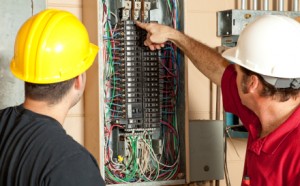Upgrade Your Home Electrical System!
 When was the last time you had to reset a circuit breaker in your house? Is your home more than twenty years old? Have you recently bought a home? Are you planning to purchase a major appliance? Now maybe a good time to upgrade your home electrical system!
When was the last time you had to reset a circuit breaker in your house? Is your home more than twenty years old? Have you recently bought a home? Are you planning to purchase a major appliance? Now maybe a good time to upgrade your home electrical system!
For homeowners, it’s not just a matter of convenience-there are significant safety issues. According to the United States Fire Administration (USFA), each year home electrical fires claim the lives of 485 Americans and injure 2,305 more. Home electrical problems account for 67,800 fires and $868 million in property losses.
Fires can be caused by electrical system failures, appliance defects, incorrectly installed wiring, misuse and poor maintenance of electrical appliances, and overloaded circuits and extension cords.
Top Causes of Home Electrical Fires
1. Inadequate electrical capacity. Today’s homes have an increasing number of devices that consume electricity including clothes dryers, water heaters, electric ranges and ovens, frost-free refrigerators, dishwashers, even media centers. In warm climates, air conditioning is a major power drain.
As you add appliances to your home, the power supply may become inadequate. Anytime you add a major appliance you should have your electrical system checked by a qualified professional. Don’t ignore warning signs like fuses or circuit breakers tripping or lights dimming!
Here are the primary causes of inadequate power in your home:
o Overloaded circuits
o Limited service panel capacity
o Insufficient number of outlets
o Overtaxed transformer
o Inadequate feeder lines
Adding receptacles (or even worse, using extension cords) does not increase the available power. If you find that you are plugging in multiple appliances into one outlet, you need to increase the power supply directly from the distribution panel.
2. Obsolete equipment or electrical systems. Thirty years ago, domestic power use was much less, even in warm climates. The average new home required 60-amp electrical service, which was connected to a screw-in fuse panel with two fuse blocks.
Ten years later the average home required 100-amp electrical service and circuit breakers had become standard equipment.
Today, the average new home is equipped with 200-amp electrical service and a distribution panel handling up to 40 fifteen-amp circuit breakers. The kitchen may be equipped with receptacles capable of supplying more than 60 amps to the countertop appliances alone. The air conditioning or HVAC system may take more power than an entire home did 30 years ago.
If your home is even twenty years old, chances are it needs to be upgraded! The thirty-year-old distribution panel in your basement or garage the one with the screw-in fuses are almost certainly a fire hazard. Why? Over time, the contacts deteriorate. The point of contact between the buss bar and the base of the fuse oxidizes or charcoals. As current flows, increased heat is generated, leading to failure or fire. In California, if a home is equipped with an electrical distribution panel that uses screw-in fuses, many insurance companies will not renew homeowner insurance.






